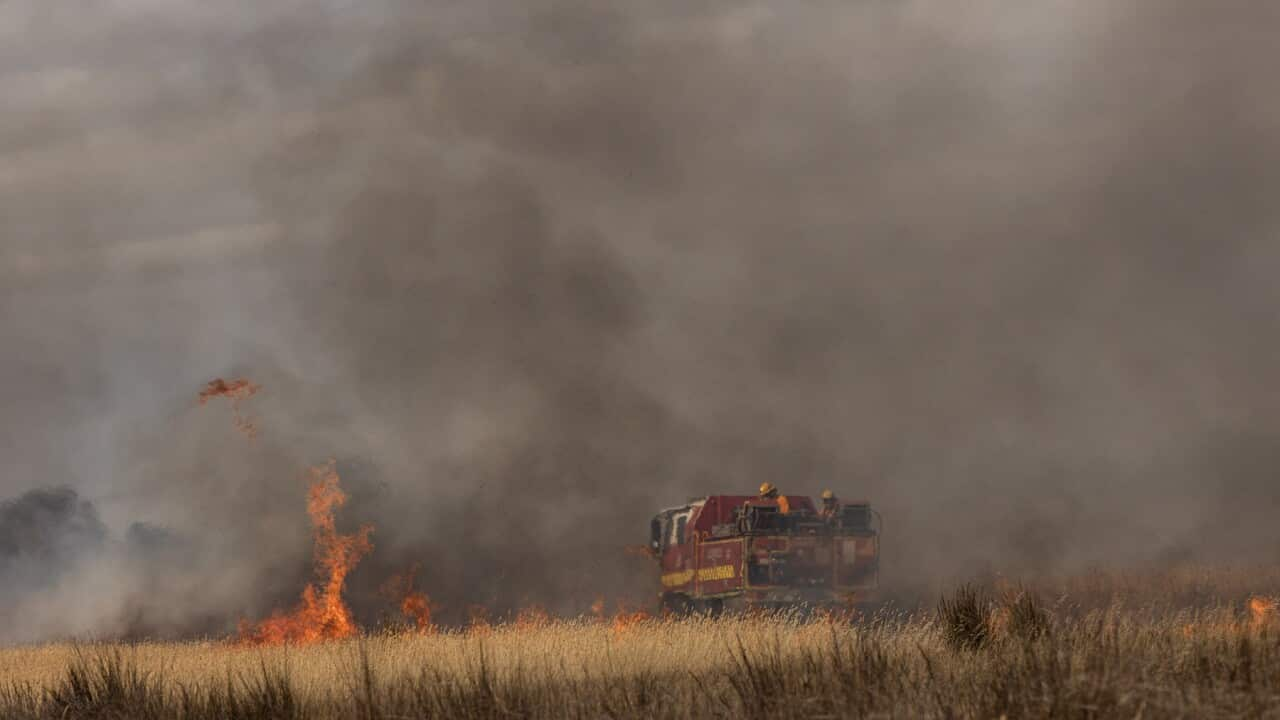TRANSCRIPT
As bushfires continues to blaze through two national parks in western Victoria, there are renewed fears for lives and property in coming days.
Dr Tamasin Ramsay is among those whose home is threatened - but she's more worried about the endangered forest and fauna nearby.
"Sometimes the way we talk about, we talk about, you know, homes and lives lost, we say, oh, you know, three homes have been lost in this fire. Well, we all have homes. We humans have homes, and other species have their homes. We have our lives, and they also have their lives. So to say that no life has been lost is not correct. There's thousands of lives lost, you know, like lizards and snakes and birds and bees and bats and macropods."
Dr Ramsay lives on a property adjoining the Grampians, or Gariwerd, National Park, where bushfires have burned through an area larger than Singapore in recent weeks.
Her property is also the home of the Wildwood Wildlife Shelter, which is run by her friend Pam Turner, who takes in injured creatures from the surrounding bushland.
And Dr Ramsay says animals injured by the bushfires have begun to trickle in.
"Some have had to be euthanised because they've got their feet are literally white hot dead tissue. They can't survive."
There's every expectation this trickle could turn into a flood.
"We've gone out to the fire ground on, you know, private land, with permission of course, and seen a lot of dead animals that have just died, as we would, from the radiant heat."
Experts are worried about what that will mean for biodiversity, with two national parks burning in the region at the same time.
Michael Clarke is an Emeritus Professor of Zoology at La Trobe University, specialising in the impact of fire on fauna.
He describes the landscape being razed.
"Little Desert's a very special place. It's a remnant heathland mixture of low-lying vegetation, lots of nectar producing plants, a really diverse flora, but it's unspectacular in the sense that it's low topography, undulating dunes and swales, with continuous variation broken up by some mallee, which are shorter eucalypts. Real contrast with the Grampians, which is rugged, mountain ranges, rocky, steep, really diverse flora again, mixtures of heath lands and eucalypt woodlands."
More than half the land has been burned out in both national parks - an area exceeding 150,000 hectares when the two are combined, and more than double the size of Singapore.
Professor Clarke says that's a huge threat to wildlife.
"They're hugely significant on the landscape level. We don't have many large remnants of uncleared vegetation in this state anymore due to white settlement. And these two national parks are hugely important as parts of the estate."
Professor Clarke says swathe of threatened species call the parks home.
"The Little Desert, there's real concerns about some bird species, the iconic mallee fowl, where the male incubates the eggs underground. One of its strongholds is a little desert, a tiny brown bird called a slender billed thornbill, one of the ones that's threatened in that part of the world, but there are also butterflies, a large ant blue butterfly, and some reptiles, a particular snake called the Bardick, and Rosenberg's goanna, these are all species that are vulnerable or threatened within the Little Desert."
The Gariwerd National Park is home to around 50 threatened species as well.
One of them is the brush-tailed rock-wallaby, which has one of its last strongholds in the park, where it was re-introduced in 2008.
The Victorian Department of Energy, Environment and Climate Action is dropping sweet potatoes, carrots and hay from the air to help provide survivors with extra food.
They're likely to need the support.
A nature campaigner with the Australian Conservation Foundation, Darcie Carruthers, explains the park has been battered by multiple fires in recent years.
"The Grampians suffered major bushfires in 2006, again in 2013, and now less than a decade later, they're on fire again."
While the landscape is highly adapted to fire, Professor Clarke explains it needs time to bounce back.
"The way we think about this in the state of Victoria at least is we look at what we think the plants in particular have evolved to cope with. And so if we imagine something like a banksia might take 15 years before it gets reproductively mature and is producing seeds that can replace itself with if we have fires in a frequency less than 15 years, then it won't have reached sexual maturity and it won't be able to replace itself and it may become locally extinct."
He says as climate change fuels fires that are larger, more frequent and more severe, they're becoming unmanageable.
"What we saw in the Little Desert was a fire that did something like a 40 kilometre run overnight. It's a massive fire. And because we've cleared so extensively in Victoria, even if that kind of fire was a natural part of the landscape free settlement because we've cleared it now and we have our national parks virtually as islands where we have the risk of these big fires taking out most of the island in one fell swoop. And that's a game changer for the wildlife."
In this landscape of islands, it's harder for wildlife to escape from the fires, and there's less food if they do.
To make matters worse, Professor Clarke says feral animals like foxes and cats often follow fire fronts to pick off survivors.
Others will likely end up staying with Dr Tamasin Ramsay, her 87-year-old father, and wildlife carer Pam.
When the fire threatened the property and wildlife shelter last month, they decided to stay - with sprinklers wetting the house, huddled in the lounge room filled with 20 joeys.
Dr Ramsay was also out on the frontlines fighting fires as a volunteer, so she knows the risks ... which are increasing again.
There are fears two fire fronts will join up in the Grampians as temperatures are tipped to reach 37 degrees this weekend.
This time, Pam has evacuated along with the animals at Wildwood Wildlife shelter, but Tamasin will stay behind with her dad.
She says they've prepared as much as they can, and been in touch with fire fighters working nearby.
"So we're not going to be stuck out there on our own. And we also do have a place of last retreat. We've got a cellar that's underground, not under the house, and we've got woollen blankets. And so we've got a place of last retreat if we have to go to. We don't think it will get to that, but still we make these decisions. But then if things change, if conditions change, then we have to respond to that as well. But that's our plan is for Rob, my dad and I to stay and to protect the place."
A place that she shares with animals when they have no place else.













